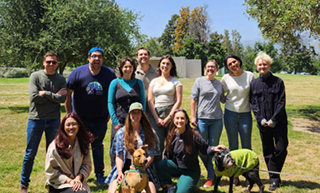
December 12, 2023
Megan Herting, Ph.D., wants to understand environmental ties between the brain and human behavior.
Although decades of research have established that contaminants in air, water, and soil affect physical health, scientists are just beginning to parse how environmental pollutants affect brain development and ensuing behavior. Herting, a behavioral neuroscientist and NIEHS grant recipient at the University of Southern California (USC), is at the forefront of this emerging field, known as environmental neuroscience.
As a first-generation college student, she was unsure about her career path. A fascination with how the brain influences behavior drew her to academia.
“I was really interested in studying experience-dependent plasticity, which is the idea that every experience a person has rewires and shapes the brain,” Herting explained.
After graduating with a degree in psychology, she earned a Ph.D. in behavioral neuroscience at Oregon Health and Science University. During a postdoc at USC, she learned about the connections between environmental health and developmental neuroscience.
“My eyes were completely opened to the idea that exposures to everyday chemicals are impacting the way our brains develop,” she recalled.
Tracking Behavioral Development Over Time
In 2016, Herting was running her own lab at USC when she joined a team of researchers from across the country on a landmark research project called the Adolescent Brain and Cognitive Development (ABCD) Study. As the largest long-term study of brain development and child health in the United States, the project tracks over 11,000 healthy participants recruited at age 9 or 10 into early adulthood.
Childhood through adolescence is a time of rapid brain development. During this period of growth, brain regions that control cognition, vision, and language undergo a set of neural processes known as peaking and pruning. Herting compares the changes to a growing tree.
“As a tree ages, it grows more tree branches and leaves. But to keep the tree healthy, you have to prune every so often to get the right balance,” she explained.
Herting (standing, third from right) relies on a team of graduate students and postdocs to leverage large datasets to analyze how air pollution exposures affect brain development outcomes and behavior changes in children. (Photo courtesy of Megan Herting)

Herting (standing, third from right) relies on a team of graduate students and postdocs to leverage large datasets to analyze how air pollution exposures affect brain development outcomes and behavior changes in children. (Photo courtesy of Megan Herting)
Similarly, neurons and synapses in the developing brain subside in some places and form in others, growing stronger and more stable. A protective sheathing process called myelination also insulates connections between brain regions, enabling faster, more efficient processing between neural networks. In adolescents, synaptic pruning and myelination increase across a brain region called the cortex, improving the efficiency of information processing.
“During this time period, children are learning to make good decisions and regulate their emotions, which is critical for the development of complex behaviors,” Herting explained.
Grants from NIEHS enable Herting’s lab to add data on air pollutant exposure to the ABCD dataset. Her team collaborates with researchers at other institutions to map levels of fine particulate matter (PM2.5), nitrogen dioxide, and ground-level ozone at each child’s residence. Then they compare that data with brain scans and responses to annual questionnaires to examine how exposures to different air pollutants impact neurodevelopment and risk for mental health problems over time.
Given the large study cohort, Herting is excited about all the possible questions that her lab will be able to investigate. So far, her work with MRI scans has shown that air pollution affects brain structure and function. They are now exploring how these impacts influence behavioral differences.
“We’re looking at the nuances of which groups are exposed to air pollution, what are their levels of exposure, and what the associations between these environmental factors and behavioral changes and changes in brain function look like,” she explained.
A Public Health Research Approach
Herting sees environmental neuroscience research on air pollutant mixtures as critical to informing air quality regulations for harmful pollutants.
“It’s important to not only look at the annual average of PM2.5 in the air, but to identify the most harmful toxicants to neural health in order to improve the regulation of air quality,” she said.
With NIEHS funding, Herting used ABCD data to publish the first study to show that childhood exposure to outdoor air pollution is linked to changes in brain development over the long term — two years, in this case — and that different pollutants affect brain connectivity in various ways.
The results provide compelling evidence that air pollution exposure is associated with differences in brain maturation in children as they transition into early adolescence, according to Herting. The next step is to monitor how those changes affect behavior over time.
“For example, do kids with high levels of exposure have learning disabilities or exhibit signs of mental health problems? Those are the questions we will be looking at,” Herting said.
For her part, Herting says that more environmental neuroscience research should be conducted through a public health lens.
“I believe that researchers should design studies that are geared toward informing public health policy,” she said.
Training the Next Generation of Environmental Neuroscientists

Herting (standing, third from right) relies on a team of graduate students and postdocs to leverage large datasets to analyze how air pollution exposures affect brain development outcomes and behavior changes in children. (Photo courtesy of Megan Herting)
Herting and her students and postdocs often take excursions, such as to the Huntington Library in San Marino, pictured above. (Photo courtesy of Megan Herting)
Looking back, Herting credits grants from NIEHS for supporting her journey into environmental neuroscience.
“The institute’s investment in me and my colleagues is building an entirely new research field,” she said.
As a senior researcher, Herting is inspired by multidisciplinary and team-science research. Mentorship is key to this approach, and she trains undergraduates, graduate students, and postdocs to investigate the impacts of air pollution on neurodevelopment.
“For me, the students are the reason I do research,” she said. “The collaborative brainstorming that’s sparked from amassing a lab filled with unique perspectives, experiences, and academic trajectories is truly remarkable. Watching my students build out great ideas and accomplish them is one of the best parts of my job.”


